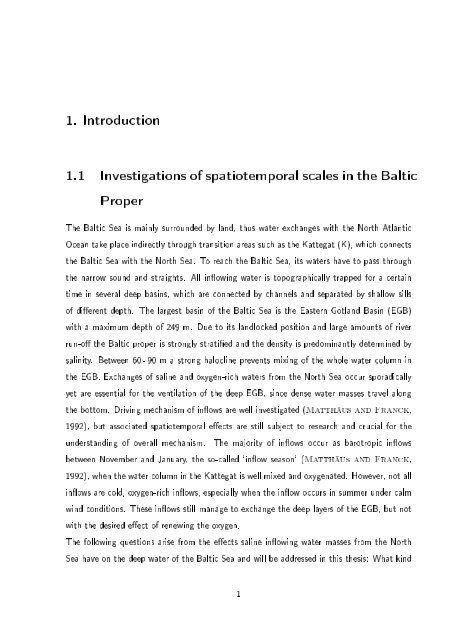Baltic Sea
Baltic Sea
Baltic Sea
Create successful ePaper yourself
Turn your PDF publications into a flip-book with our unique Google optimized e-Paper software.
1. Introduction<br />
1.1 Investigations of spatiotemporal scales in the <strong>Baltic</strong><br />
Proper<br />
The <strong>Baltic</strong> <strong>Sea</strong> is mainly surrounded by land, thus water exchanges with the North Atlantic<br />
Ocean take place indirectly through transition areas such as the Kattegat (K), which connects<br />
the <strong>Baltic</strong> <strong>Sea</strong> with the North <strong>Sea</strong>. To reach the <strong>Baltic</strong> <strong>Sea</strong>, its waters have to pass through<br />
the narrow sound and straights. All inowing water is topographically trapped for a certain<br />
time in several deep basins, which are connected by channels and separated by shallow sills<br />
of dierent depth. The largest basin of the <strong>Baltic</strong> <strong>Sea</strong> is the Eastern Gotland Basin (EGB)<br />
with a maximum depth of 249 m. Due to its landlocked position and large amounts of river<br />
run-o the <strong>Baltic</strong> proper is strongly stratied and the density is predominantly determined by<br />
salinity. Between 60 - 90 m a strong halocline prevents mixing of the whole water column in<br />
the EGB. Exchanges of saline and oxygen-rich waters from the North <strong>Sea</strong> occur sporadically<br />
yet are essential for the ventilation of the deep EGB, since dense water masses travel along<br />
the bottom. Driving mechanism of inows are well investigated (Matthäus and Franck,<br />
1992), but associated spatiotemporal eects are still subject to research and crucial for the<br />
understanding of overall mechanism. The majority of inows occur as barotropic inows<br />
between November and January, the so-called 'inow season' (Matthäus and Franck,<br />
1992), when the water column in the Kattegat is well mixed and oxygenated. However, not all<br />
inows are cold, oxygen-rich inows, especially when the inow occurs in summer under calm<br />
wind conditions. These inows still manage to exchange the deep layers of the EGB, but not<br />
with the desired eect of renewing the oxygen.<br />
The following questions arise from the eects saline inowing water masses from the North<br />
<strong>Sea</strong> have on the deep water of the <strong>Baltic</strong> <strong>Sea</strong> and will be addressed in this thesis: What kind<br />
1



